Articles that can help you save money
Part I - Aluminum furnace tape:
With all the redneck jokes about duct tape, I almost hate to suggest this stuff, but.....
Do you have a building or car that 'glows' due to light seeping through?
Do you want to add 'seams' to an otherwise plain sheet roof or wall?
Do you need to fill a gap with putty and need to back it with something so it doesn't fall through?
Do you need 'windows', but don't want to cut holes? Or don't want anybody to be able to see the interior?
Do you need a model mirror?
Do you need 'chrome' trim?
Do you need harnesses for your horses?
Do you need a quick and easy moisture or insect barrier on the bottom of a wood model?
Do you need to conduct electricity but don't have anywhere to hide the unsightly wires?
Do you need to hinge a small opening, but can't attach a real one?
You can do all those things with furnace tape. It's basically adhesive backed foil. You can cut it in strips or shapes with scissors as easily as paper, rub it with a round tool to emboss it to irregular surfaces. Bugs won't eat it, light can't penetrate it, if sealed down properly water won't penetrate it. It's polishable. paintable, tough yet summat flexible, heat resistant, and sticky on one side for easy mounting..... and it's cheap. - As in the neighborhood of $8 for a 75 foot roll. You just cut it to size/shape, peel the backing, stick, then burnish it in place to get any wrinkles out. The only major drawback is sometimes it's a bit TOO sticky should you decide you need to remove it in one piece to reposition it.
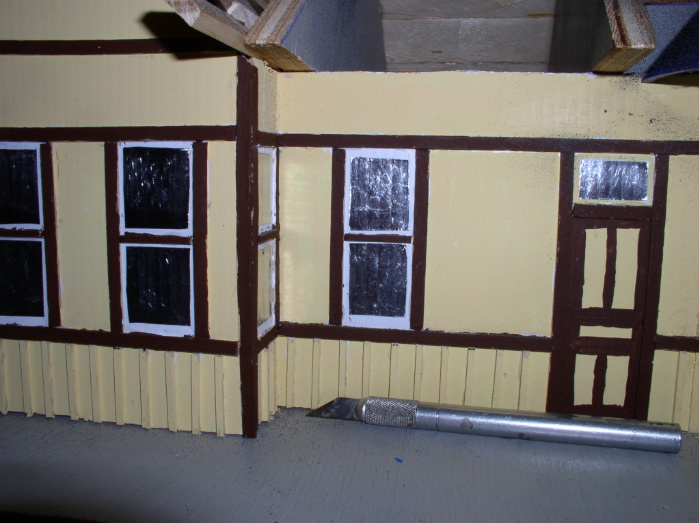
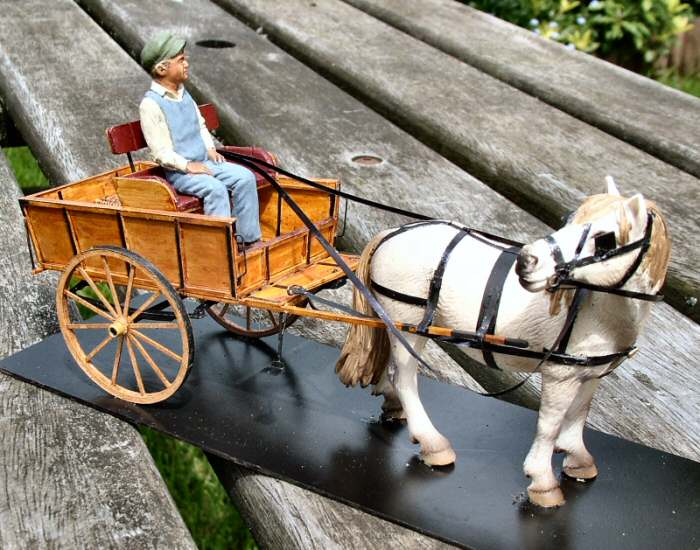
(Peter Bunce photo)
Part II - Alleywood:
"Alleywood" is a traditional term used to describe a building materials that you didn't have to pay for - construction scraps, broken pallets, furniture factory discards, old broken fence posts, etc. ie. any odd bits of wood you might find in an alley.... are alleywood
Today, we can easily stretch the definition to include wood coffee stirrers, discarded advertising stuff of any material (acrylic, coroplast, etc), and even plastic or foam packaging from some product.
Most often for a model you don't NEED big pieces, just lots of little ones. Alleywood is generally short bits that other folks didn't want anyway
Need stripwood but can only find an old board? Pull the nails and rip a with a saw. (use a fence and a pusher stick for small work - safety first!)
Need a building to be more rigid? Back the joints with triangles of alleywood. Or a big chunk in the base can add weight to keep it from moving with the wind.
Need roof trusses? Triangles made of old plywood are fast and easy.
Even stuff that was metal in the real world, like girder bridges, can be modeled from alleywood. Just seal it good and paint it.
Need walls or roof parts? Outdated advertising signs come in many sizes and are easily cut down.
Some containers for mechanical pencil leads can be made into credible mileposts.
Half & Half cups from restaurants can be combined with an aluminum bottle cap to make a reasonable trash can
Empty ballpoint? The 'tube'can be used, for instance as a simple chimney.
Need window 'glass'? Look at that blister pack you were going to toss out again....
And the best part? It didn't cost you a thing!
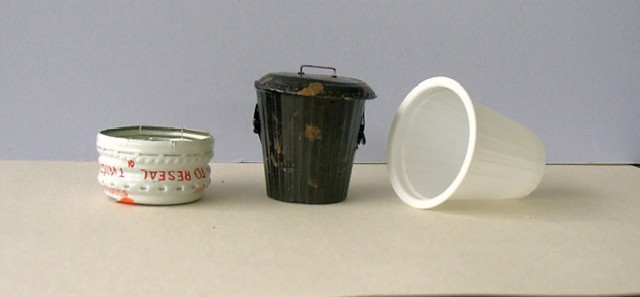
(Dave Meashey photo)
Part III - Floral Wire, Beads, Dress Snaps, and Other Craft 'Stuff':
These ideas are so simple and inexpensive, yet elegant, that I really wish I could claim credit for them.
Floral wire comes in several gauges and materials and can be bare or plastic coated. It usually comes in rolls for a few dollars. Jewelry wire is usually made of soft brass and thinner yet.... between them there are a lot of good choices for inexpensive pipes, grabirons, handrails, stanchions, wires and supports.
Plastic beads come in lots of sizes shapes and colors. round ones can be made into valve bodies, clear ones can be lantern globes, tubes can become pipe fittings.
Buttons make pretty good cylinder heads.
Sew on snaps make dandy handwheels. They come in lots of sizes. #4 and #6 work well for most large scale locomotive piping
Craft store wood turnings can become vents, chimney caps, lantern tanks, even crank discs.
Lemax resin village figures, available at Christmas, are often significantly less expensive than those made for specifice modelers, too.
Part IV - Flea Markets, Yard Sales, Thrift Shops:
One of the best things about adaptive re-use is you're not only saving money, you're saving landfill space as well. Even if outright dumpster diving is beneath your dignity (or illegal in your area), there are always plenty of yard sales and thrift shops with all kinds of treasures just waiting to be discovered. A toy with pieces missing can become something unique. Used diecast cars and toy animals can be found at a fraction of the cost of new.
The WWI Flying Ace cost me a whole 25c at a yard sale. He was one lonely piece left from what originally was a set. But I've lost count of how many kids (and adults) pointed and joyfully said "SNOOPY!" when they first see him. And all I did was bring him home and put him on the layout.
This Cletrac dozer started out a damaged resin one from a flea market for $5.
As purchased:
Old toys and obsolete business machines can also provide you with a wealth of usable bits - motors, gears, shafts, wheels, etc.
Just keep your eyes (and mind) open, and you never know what you'll find! It's something anyone can learn. There are a few easy tricks to check scale that I'll share in the next installment.
Part V - Will it work? Can I make it work?
Life doesn't always come included with tidy little tags with the scale printed on it. If it does, I missed them. Sometimes you will come across an item that's almost perfect.... except you're not sure it will actually work with what you already have.... So how can you tell?
You could always cart it home anyways... except SWMBO might begin to get a wee bit upset with the clutter after a bit.
You could always buy one of those little 99c keyring tape rules and keep your keys on it.
Or you could carry around a little plastic dude, just in case. ("Excuse me sir, is that a 1:20 cowboy in your pocket, or are you happy to see me?")
There HAS to be an easier way, right? Got a dollar in your pocket? US currency bills are are 2.61 inches wide and 6.14 long. How about a credit card? They are 2 1/8" high and 3 3/8" inches wide. Useless trivia? Measure that little plastic cowboy again. Better yet, hold him up against the bill and the card. See anything?
A dollar folded in half is 6 feet in 1:24. The other dimension is pretty close to the height of a figure in 1:29. That credit card is 5' 8" wide in 1:20...... And folks won't wonder if you're senile when you take them out of your pocket.
Still not sure? Houses come in all shapes and sizes. But doorknobs are usually pretty much about the same height. (usually between 30-36" from the floor.) Fold that folded dollar bill in half again.
Let's assume for a minute that you've already brought whatever it was home, only to find it's NOT the scale you thought it was. It's either too big or too small, so it's totally useless. right?.... not necessarily!
Option 1: Use it anyway.... Our brains are funny. Your eye pretty much sees what it expects to see... it's 'rubber ruler' is worse than anything LGB ever thought of. If something is too small, but the stuff around it is proportional to it. Our brain processes them as simply being further away, It's a little trick called "forced perspective." A slightly too large item can often be hidden in the foreground the same way.
Option 2: Remodel minor (or possibly major) details.... Industrial machinery often has a 'family resemblance' across the various sizes/models of the same manufacture. A diecast 1/16 cat 22 crawler can become a cat 60 in 1/24 with a little work. Or a 1/32 toy crane can become a 1/24 crane with a little more.
From this:
to this:
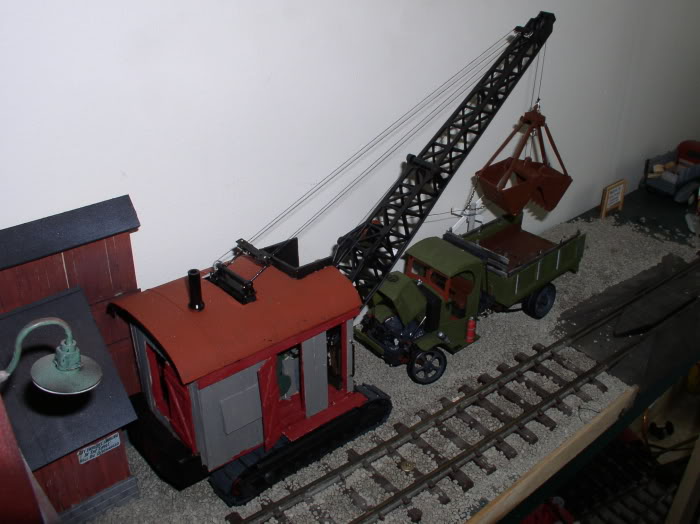
Option 3: Use what you can for parts!..... The Bachmann "G scale" coaling tower is actually O-scale with a letter changed on the instructions. But you can make an OK g-scale model from most of it....
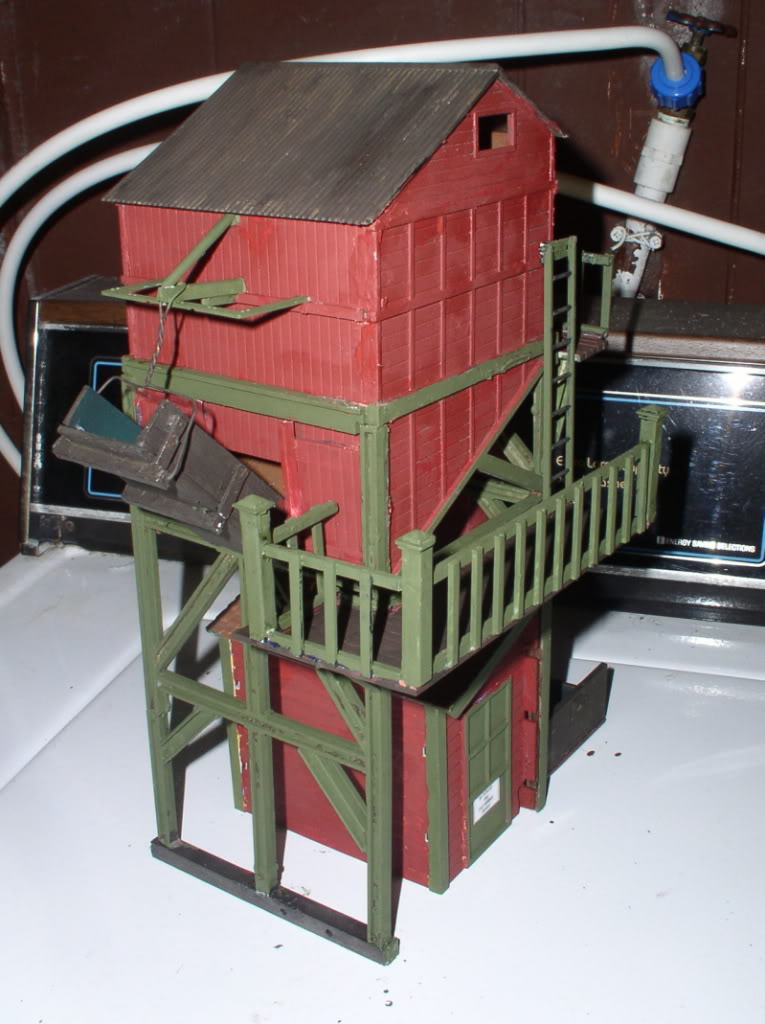
Option 4: Trade it off to someone else. Or put it out at your own yard sale for a quarter. If you can get four quarters together and trade them in, you're back to that handy dollar bill.
Part VI - Drawings, Photos, and Scale:
Sometimes you may want to make a model of a real object. You have 4 choices; measure the real item or even another model, work from plans, work from photos, or wing it from memory.
Lets go through that list backwards -
#4. Wing it from memory. - Unless you have an eidetic memory, it probably isn't gonna come out anywhere really close to the original. However, if that's all you have - say of the house your mom grew up in - and if you don't care about being "perfect" and just want an impression of the real thing. It works just fine. I do this 6-7% of the time.
#3 Work from Photos. - There's actually two ways to work from photos. You can use them as a visual guide for layout and proportions, and make an educated guess on the actual measurements.- Or you can measure the height of something in the photo that you already know the size of (like a person) and then measure everything else by this 'base scale' to get the measurements you need. Easy with straight on shots. And there is a computer program that will adjust angled photos for you to get the information from angled ones. The first is actually what I do about 90% of the time. The 2nd sometimes.
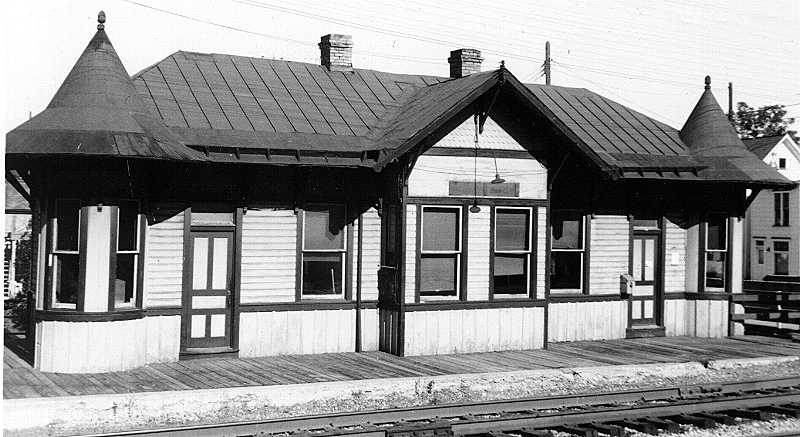
Another good method for building from pictures is to use an image software program - Such as Google Sketchup to create scaled drawings to work from.
#2 Work from plans. - If you have access to either full sized plans or ones in your chosen scale, you're "in like Flynn". Otherwise, you might think you're in trouble... But actually you're not.....
If you have a calculator or can do a bit of fairly simple math in your head. The thing to remember about scale, ANY scale, is that it is a mathematical ratio. F-scale 1/20.3 means that 1 inch on the model equals 20.3 inches (or a bit less than 2 feet) on the real thing. Likewise HO 1/87 means 1" on the model is 87" (or a bit over 7 feet) on the prototype.
What you should be getting from the above three sentences is the key to unlocking ANY drawing. If the drawing is dimensioned with 'full scale' - ie prototype numbers, you simply convert those to your chosen scale. If you have to take measurements from the drawing, you can not only infer the prototype measurements, you can actually convert them directly to the scale you are building in.
The ratio between HO scale and F scale is 4.285714 - I think most folks will agree that multiplying the HO measurements by 4.25 (1:20.47 scale) or even 4 (1:21.75 scale) is "close enough" for most model work. Also, those same HO measurements multiplied by 3 gives you 1:29 scale.
O scale is usually 1:48 I'll leave you to work out the key.
#1. Measure the real thing. - Occasionally you can, like if you're making a model of your own house, just take those real world measurements and divide by the scale you're using. Working from another model uses the same conversion calculations as we discussed with the plans, above.
Now is also probably the time to have a brief discussion about something called "selective compression". Most structural models are compressed (smaller than full scale ones) because, frankly, many real world buildings are simply too honking HUGE for most layouts. There's two main ways to compress, a change of scale (Many HO buildings are actually 1:100) or selective compression, ie reducing size by removing part of the structure. The V&T shops and yards at Carson City, for example, would be 55 feet by 217 feet in 1/20
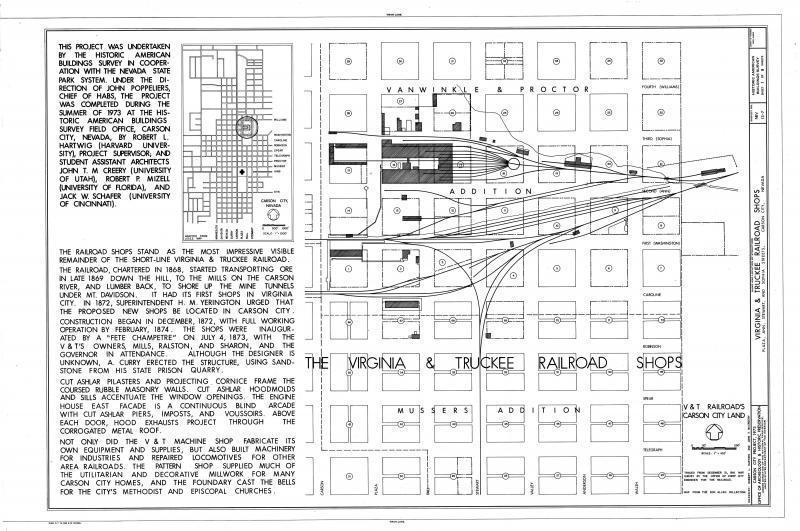
........Bigger than many, if not most, people's entire layouts.
First, lets just look at the shop building itself: It is 11 bays wide, with 33 widows and 2 doors down the sides. Try reducing that by roughly 30% -- 7 bays wide, w/ 20 windows and 1 or 2 doors -- It would still be pretty darn big, but perhaps manageable on a large layout. To keep the proportions within reason you'd have to also shorten the height by about 5-10%, as well,
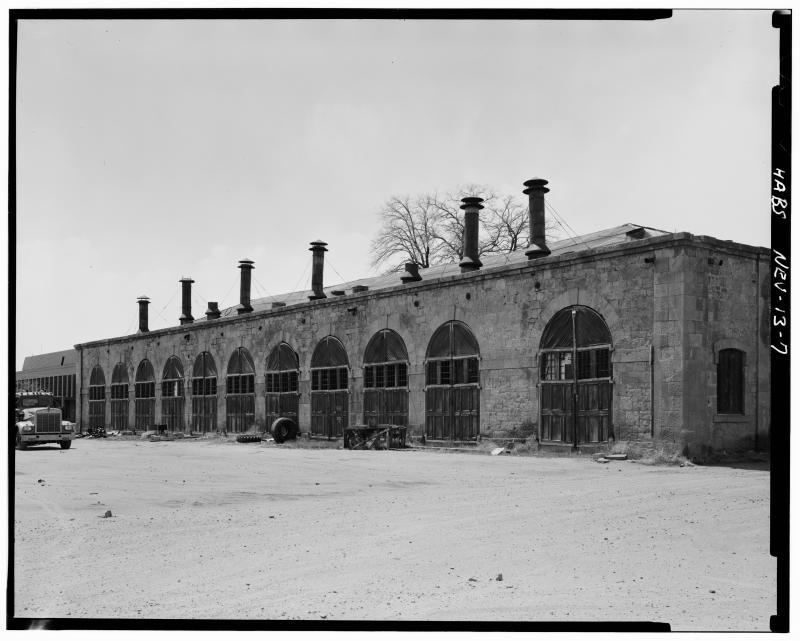
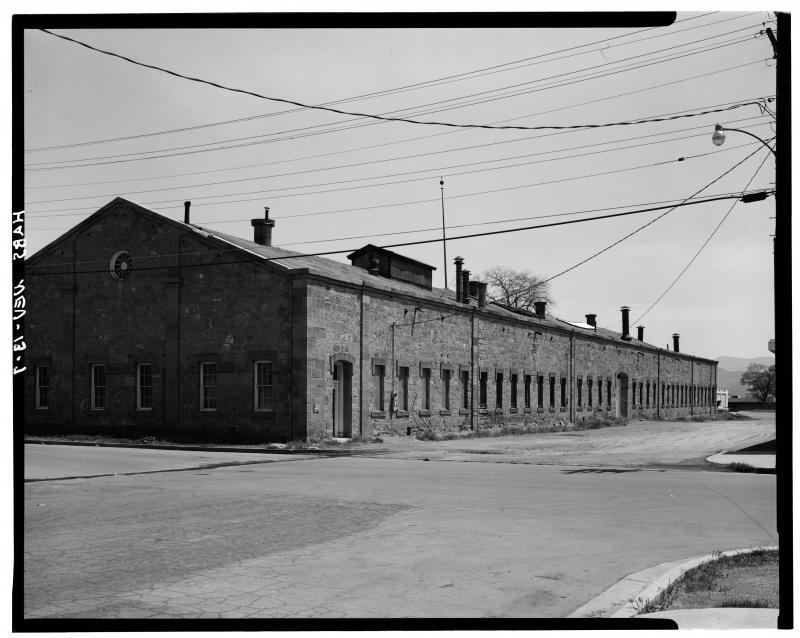
The yards? What about reducing the number of various sidings in the yard from 15 to about 7 or 8 and shortening them? How about making the wye smaller? What about simply eliminating some of the outbuildings and some of the passing trackage? A lot less space, but as long as the general layout of the trackplan is about the same, most folks, even V&T fans, won't even notice. And you won't have to buy the neighbor's lot and take out a 3rd mortgage to build it.
Unfortunately, you CAN also OVER compress it. You also have to remember to compress the carloads, etc. It is sometimes a bit unsettling to see a model of 'industrial building' the size of a typical house, and railroad services them more then they would typically need. I remember a gent who wanted a mine to fit in something like 3 square feet and yet still serve 2 tracks. Reducing it so much that it seems totally unrealistic can be just as bad as so big it's overwhelming..
However......
One of the things you CAN do is stress artistic impression over scale
fidelity. My coal mine complex is
absolutely huge by many folks model standards. At 5 feet by 7, it takes
up almost a quarter of my layout. But it's ridiculously tiny by real
world standards. It also only serves one track that will hold 4
hoppers..... a real RR probably would not have even bothered even putting in a
siding, BUT it's smallish buildings again work together as an
impression of a coal mine. As you can see, trying to put in a 2nd siding simply ruins the impression.
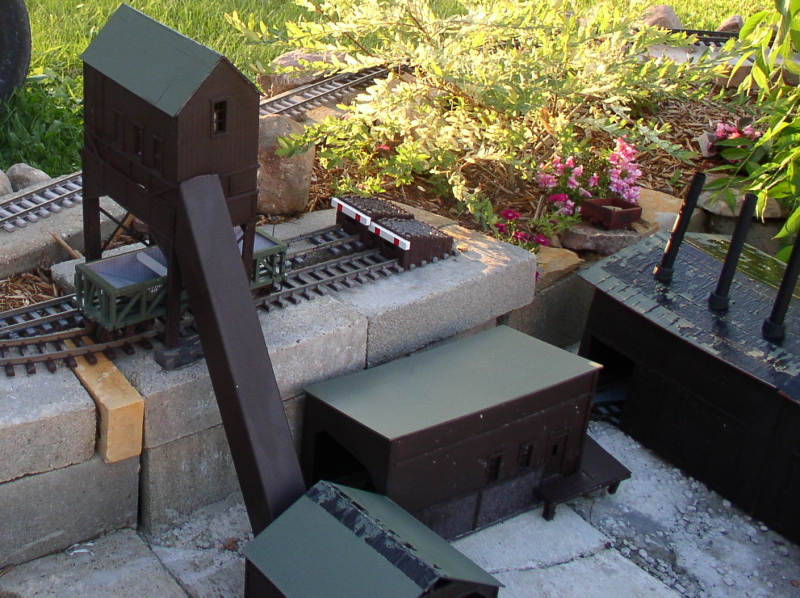
One last thing to remember: Somewhere you'll always
have to make a compromise. A scale mile in 1/20 is 260 feet. A really
short shortline is about 10 miles. Most small towns have several hundred
buildings. I don't think many folks have that kind of space or money.
Here endeth today's lesson, lol......